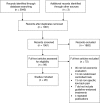Cost-effectiveness of guideline-endorsed treatments for low back pain: a systematic review - PubMed (original) (raw)
Review
Cost-effectiveness of guideline-endorsed treatments for low back pain: a systematic review
Chung-Wei Christine Lin et al. Eur Spine J. 2011 Jul.
Abstract
Healthcare costs for low back pain (LBP) are increasing rapidly. Hence, it is important to provide treatments that are effective and cost-effective. The purpose of this systematic review was to investigate the cost-effectiveness of guideline-endorsed treatments for LBP. We searched nine clinical and economic electronic databases and the reference list of relevant systematic reviews and included studies for eligible studies. Economic evaluations conducted alongside randomised controlled trials investigating treatments for LBP endorsed by the guideline of the American College of Physicians and the American Pain Society were included. Two independent reviewers screened search results and extracted data. Data extracted included the type and perspective of the economic evaluation, the treatment comparators, and the relative cost-effectiveness of the treatment comparators. Twenty-six studies were included. Most studies found that interdisciplinary rehabilitation, exercise, acupuncture, spinal manipulation or cognitive-behavioural therapy were cost-effective in people with sub-acute or chronic LBP. Massage alone was unlikely to be cost-effective. There were inconsistent results on the cost-effectiveness of advice, insufficient evidence on spinal manipulation for people with acute LBP, and no evidence on the cost-effectiveness of medications, yoga or relaxation. This review found evidence supporting the cost-effectiveness of the guideline-endorsed treatments of interdisciplinary rehabilitation, exercise, acupuncture, spinal manipulation and cognitive-behavioural therapy for sub-acute or chronic LBP. There is little or inconsistent evidence for other treatments endorsed in the guideline.
Figures
Fig. 1
Flow of study
Similar articles
- Comparative effectiveness of exercise, acupuncture, and spinal manipulation for low back pain.
Standaert CJ, Friedly J, Erwin MW, Lee MJ, Rechtine G, Henrikson NB, Norvell DC. Standaert CJ, et al. Spine (Phila Pa 1976). 2011 Oct 1;36(21 Suppl):S120-30. doi: 10.1097/BRS.0b013e31822ef878. Spine (Phila Pa 1976). 2011. PMID: 21952184 Review. - Cost-effectiveness of general practice care for low back pain: a systematic review.
Lin CW, Haas M, Maher CG, Machado LA, van Tulder MW. Lin CW, et al. Eur Spine J. 2011 Jul;20(7):1012-23. doi: 10.1007/s00586-010-1675-4. Epub 2011 Jan 4. Eur Spine J. 2011. PMID: 21203890 Free PMC article. Review. - Cost-Effectiveness of Non-Invasive and Non-Pharmacological Interventions for Low Back Pain: a Systematic Literature Review.
Andronis L, Kinghorn P, Qiao S, Whitehurst DG, Durrell S, McLeod H. Andronis L, et al. Appl Health Econ Health Policy. 2017 Apr;15(2):173-201. doi: 10.1007/s40258-016-0268-8. Appl Health Econ Health Policy. 2017. PMID: 27550240 Review. - Massage for low-back pain: a systematic review within the framework of the Cochrane Collaboration Back Review Group.
Furlan AD, Brosseau L, Imamura M, Irvin E. Furlan AD, et al. Spine (Phila Pa 1976). 2002 Sep 1;27(17):1896-910. doi: 10.1097/00007632-200209010-00017. Spine (Phila Pa 1976). 2002. PMID: 12221356 Review. - Effectiveness and Economic Evaluation of Chiropractic Care for the Treatment of Low Back Pain: A Systematic Review of Pragmatic Studies.
Blanchette MA, Stochkendahl MJ, Borges Da Silva R, Boruff J, Harrison P, Bussières A. Blanchette MA, et al. PLoS One. 2016 Aug 3;11(8):e0160037. doi: 10.1371/journal.pone.0160037. eCollection 2016. PLoS One. 2016. PMID: 27487116 Free PMC article. Review.
Cited by
- Cost-Efficiency and Effectiveness of Including Doctors of Chiropractic to Offer Treatment Under Medicaid: A Critical Appraisal of Missouri Inclusion of Chiropractic Under Missouri Medicaid.
McGowan JR, Suiter L. McGowan JR, et al. J Chiropr Humanit. 2019 Dec 10;26:31-52. doi: 10.1016/j.echu.2019.08.004. eCollection 2019 Dec. J Chiropr Humanit. 2019. PMID: 31871437 Free PMC article. Review. - Prognostic Factors for Outcome of Fusion Surgery in Patients With Chronic Low Back Pain - A Systematic Review.
Meester RJ, Jacobs WCH, Spruit M, Kroeze RJ, van Hooff ML. Meester RJ, et al. Global Spine J. 2025 Jan;15(1):251-266. doi: 10.1177/21925682241286031. Epub 2024 Sep 20. Global Spine J. 2025. PMID: 39303056 Free PMC article. Review. - [Acupuncture in orthopedics].
Molsberger A. Molsberger A. Orthopade. 2012 Feb;41(2):100-5. doi: 10.1007/s00132-011-1865-8. Orthopade. 2012. PMID: 22349367 German. - [Effects of interdisciplinary functional restoration treatment with cognitive behavior therapy in patients with chronic back pain: healthcare research in the context of selective contracts].
Hafenbrack K, Heinrich M, Müller G, Marnitz U, Mallwitz J, Klinger R. Hafenbrack K, et al. Schmerz. 2013 Dec;27(6):566-76. doi: 10.1007/s00482-013-1377-z. Schmerz. 2013. PMID: 24337423 Clinical Trial. German. - Prevalence of claims-based recurrent low back pain in a Canadian population: a secondary analysis of an administrative database.
Beaudet N, Courteau J, Sarret P, Vanasse A. Beaudet N, et al. BMC Musculoskelet Disord. 2013 Apr 29;14:151. doi: 10.1186/1471-2474-14-151. BMC Musculoskelet Disord. 2013. PMID: 23628144 Free PMC article.
References
- Chou R, Qaseem A, Snow V, Casey D, Cross JT, Jr, Shekelle P, Owens DK, Clinical Efficacy Assessment Subcommittee of the American College of Physicians; American College of Physicians; American Pain Society Low Back Pain Guidelines Panel Diagnosis and treatment of low back pain: a joint clinical practice guideline from the American College of Physicians and the American Pain Society. Ann Intern Med. 2007;147(7):478–491. - PubMed
Publication types
MeSH terms
LinkOut - more resources
Full Text Sources
Miscellaneous
